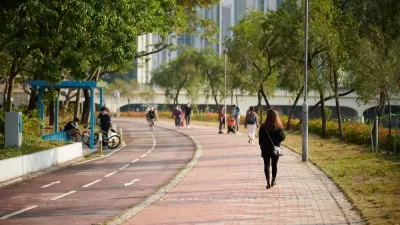A recent tour through housing developments in Hong Kong shows that the large spaces Americans treasure in homes are not necessarily the best method for urbanizing areas, according to this post.
"Hong Kong takes smallness to the extreme. It appears to be driven more by high housing costs than by concern for the environment. Most new housing takes the form of high-rise apartment buildings with tiny units. A 430-square-foot apartment in the recently completed Ching Ho Public Housing Estate, for example, was designed to be occupied by a family of five. Ching Ho represents the state-of-the-art in public housing design in Hong Kong, and the 70 square feet per occupant is the most generous allotment yet by the Hong Kong Housing Authority.
By comparison, we Americans are veritable space hogs. According to the U.S. Census Bureau, the average size of a new single-family home in the U.S. swelled to more than 2,500 square feet in 2007, although it has dipped slightly in recent years. Average household size in the U.S. is less than three people."
The smaller sizes reduce consumption of energy and goods, but the author concedes that living in a 430-square foot apartment might be difficult to get used to.
FULL STORY: Space Hogs in Hong Kong

Maui's Vacation Rental Debate Turns Ugly
Verbal attacks, misinformation campaigns and fistfights plague a high-stakes debate to convert thousands of vacation rentals into long-term housing.

Planetizen Federal Action Tracker
A weekly monitor of how Trump’s orders and actions are impacting planners and planning in America.

San Francisco Suspends Traffic Calming Amidst Record Deaths
Citing “a challenging fiscal landscape,” the city will cease the program on the heels of 42 traffic deaths, including 24 pedestrians.

Defunct Pittsburgh Power Plant to Become Residential Tower
A decommissioned steam heat plant will be redeveloped into almost 100 affordable housing units.

Trump Prompts Restructuring of Transportation Research Board in “Unprecedented Overreach”
The TRB has eliminated more than half of its committees including those focused on climate, equity, and cities.

Amtrak Rolls Out New Orleans to Alabama “Mardi Gras” Train
The new service will operate morning and evening departures between Mobile and New Orleans.
Urban Design for Planners 1: Software Tools
This six-course series explores essential urban design concepts using open source software and equips planners with the tools they need to participate fully in the urban design process.
Planning for Universal Design
Learn the tools for implementing Universal Design in planning regulations.
Heyer Gruel & Associates PA
JM Goldson LLC
Custer County Colorado
City of Camden Redevelopment Agency
City of Astoria
Transportation Research & Education Center (TREC) at Portland State University
Jefferson Parish Government
Camden Redevelopment Agency
City of Claremont





























